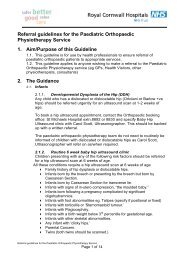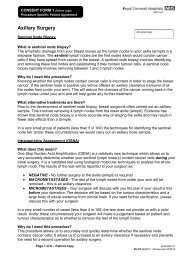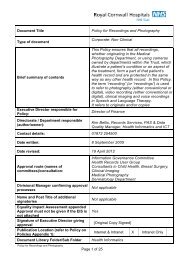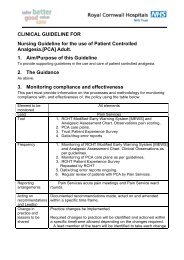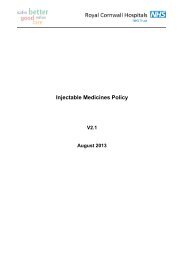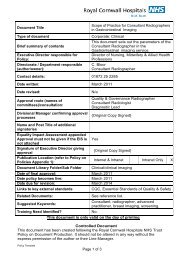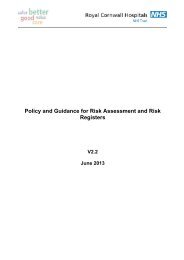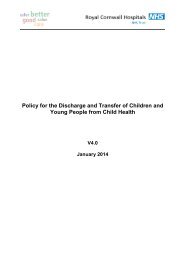Catheterisation in Adults - the Royal Cornwall Hospitals Trust ...
Catheterisation in Adults - the Royal Cornwall Hospitals Trust ...
Catheterisation in Adults - the Royal Cornwall Hospitals Trust ...
Create successful ePaper yourself
Turn your PDF publications into a flip-book with our unique Google optimized e-Paper software.
Patients will have <strong>the</strong>ir ur<strong>in</strong>ary ca<strong>the</strong>ter <strong>in</strong>serted/renewed us<strong>in</strong>g an agreed procedure and aplan of care developed to meet <strong>the</strong>ir <strong>in</strong>dividual needsReview and Amendment LogVersion No Type of Change Date Description of change3 of 16
sal<strong>in</strong>e is su itable. Observations should be recorded rout<strong>in</strong>ely 6<strong>in</strong>dicated.monthly or as cl<strong>in</strong>ically4.11 Chang<strong>in</strong>g <strong>the</strong> Ca<strong>the</strong>terThe pr<strong>in</strong>ciples of asepsis should apply to th e procedure of ur<strong>in</strong>ary ca<strong>the</strong>terisation, bothurethral and suprapubic (Appendix 3).For reca<strong>the</strong>terisation procedures, <strong>the</strong> exist<strong>in</strong>g ca<strong>the</strong>ter should be re moved, exam<strong>in</strong>ed forencrustations and disca rded at <strong>the</strong> start of <strong>the</strong> procedure. Extreme care should be takenwith supra-pubic ca<strong>the</strong> ters changes for those patients who are receiv<strong>in</strong>g anticoagulant<strong>the</strong>rapy or who have blood clott<strong>in</strong>g disorders.The first ch ange for both routes of entry <strong>in</strong>to <strong>the</strong> bladder can be don e <strong>in</strong> <strong>the</strong> co mmunity,ei<strong>the</strong>r <strong>in</strong> <strong>the</strong> patient’s home, community cl<strong>in</strong>ic or hospital by a competent HCP. Unless <strong>the</strong>reis a need for reca<strong>the</strong>terisation <strong>in</strong> a controlled environment, <strong>the</strong>re is no rationale fo r it to beonly done <strong>in</strong> a hospital sett<strong>in</strong>g. Urethral and supra-pubic lo ng-term ca<strong>the</strong>ters can be left <strong>in</strong>place for up to 12 w eeks, but reca<strong>the</strong>terisations may need to be carried ou t soonerdepend<strong>in</strong>g on <strong>in</strong>dividual needs. Some patients and <strong>in</strong>f ormal carers can be taug ht how tochange <strong>the</strong>ir own urethral or supra-pubic ca<strong>the</strong>ter.Conversion to suprap ubic ca<strong>the</strong>terisation from urethral ca<strong>the</strong>terisation is no t alwayssuccessful for female patients, as <strong>the</strong>re is a considerable risk of co<strong>in</strong>cidental urethralleakage, and patients should be warned of this risk.4.12 Patient EducationPatients (and carers) need to be <strong>in</strong>volved <strong>in</strong> <strong>the</strong>ir care, which <strong>in</strong>cludes b e<strong>in</strong>g aware of <strong>the</strong>complications of cath eterisation and correct <strong>in</strong>formation on general ca<strong>the</strong>ter car e. It isimportant that patients (and carers) know how t o identify a potential problem (Appendix 4)and whom to contact f or help. A programme of learn<strong>in</strong>g should <strong>in</strong>clude appr opriateliterature, i.e. leaflets; Ca<strong>the</strong>ter Passport. It is r ecommended that HCPs document that thishas been done.Advice on c are options regard<strong>in</strong>g sexual activity and ca<strong>the</strong> ters should be offered. Theseoptions may <strong>in</strong>clude teach<strong>in</strong>g <strong>the</strong> patient how to remove and re<strong>in</strong>sert <strong>the</strong> ca<strong>the</strong>ter before andafter <strong>in</strong>tercourse.4.13 Ur<strong>in</strong>e Sampl<strong>in</strong>gRout<strong>in</strong>e collection of ur<strong>in</strong>e specimens for cultur e is not useful and is unnecessary unless <strong>the</strong>patient is symptomatic (Nicolle 200 1). When a specimen collection is justified, a cl<strong>in</strong>icallyclean technique should be used, with dis<strong>in</strong>fection of <strong>the</strong> needle-free sample port with alcohol70% and chlorhexid<strong>in</strong>e 2% and allowed to dry t horoughly (Cl<strong>in</strong>ical Microbiology March 2012(BSOP 41)). It is important to <strong>in</strong>clude systemic symptoms on <strong>the</strong> cl<strong>in</strong>ical microbiology form.4.14 Care of <strong>the</strong> Suprapubic SiteIf dress<strong>in</strong>gs are cl<strong>in</strong>ically required, t hey must be sterile an d applied us<strong>in</strong>g an ase ptic nontouchtechnique. In most ca ses, a dress<strong>in</strong>g will not be required and patients sh ould beencouraged to clean <strong>the</strong> site daily.4.15 TraumaCa<strong>the</strong>ter tub<strong>in</strong>g and <strong>the</strong> dra<strong>in</strong>age bag should be secured to <strong>the</strong> leg so that it avoids k<strong>in</strong>ks <strong>in</strong><strong>the</strong> tub<strong>in</strong>g, t raction on t he bladder neck, trauma to <strong>the</strong> urethra, occlu sion of <strong>the</strong> ca<strong>the</strong>ter8 of 16
lumen, or caus<strong>in</strong>g excessive constriction to <strong>the</strong> limb. There are different choices of fixationmethod, such as strap s or sleeves, which needs to be based on <strong>in</strong>dividual need. It isimportant to allow enough slack to accommodate penile e rection, thus m<strong>in</strong>imis<strong>in</strong>g risk ofurethral meatus <strong>in</strong>jury. Tape should not be used as ca<strong>the</strong>ter material could be damaged dueto solvents.4.16 Bag positionDra<strong>in</strong>age bags need t o be positio ned below t he level of <strong>the</strong> bladder to avoid h ydrostaticsuction, which can cause damage to <strong>the</strong> bladd er mucosa. Higher rates of bacter iuria havebeen l<strong>in</strong>ked to <strong>in</strong> correct position<strong>in</strong>g. Dra<strong>in</strong>age bags should be atta ched to a stand thatprevents contact with <strong>the</strong> floor. To avoid sk<strong>in</strong> irritation and damage, alternat<strong>in</strong>g <strong>the</strong> leg onwhich <strong>the</strong> dra<strong>in</strong>age bag is secured will m<strong>in</strong>imise this risk.4.17 Bag empty<strong>in</strong>gWhenever possible, patients should be encouraged to empty <strong>the</strong>ir own dra<strong>in</strong>age bag. If thisis not possible, <strong>the</strong> HCP or carer should wear non-sterile g loves, apron and goggles where<strong>the</strong> risk of splash <strong>in</strong>jury is anticipated. Patients should have <strong>the</strong>ir own conta<strong>in</strong>ers, w hich areei<strong>the</strong>r disposable or heat-dis<strong>in</strong>fected to prevent cross-<strong>in</strong>fection.For patients <strong>in</strong> hospital, a s<strong>in</strong>gle-use pulp product should be used to empty ur<strong>in</strong>e <strong>in</strong>to and<strong>the</strong>n macerated. Where this is not available, a s<strong>in</strong>gle-use sterile jug should be used for eachepisode of bag empty<strong>in</strong>g or a sterile jug that can be retu rned to CSSD. Additionally, it isimportant to avoid conta m<strong>in</strong>ation of <strong>the</strong> tap or <strong>the</strong> environment by spillage. When dr a<strong>in</strong>agebags are three-quarters full, <strong>the</strong>y should be emptied to avoid traction on <strong>the</strong> bladder.However, <strong>the</strong> closed system should not be broken more than is necessary. It is reportedthat decontam<strong>in</strong>ation of outlet spouts with an alcohol wipe is <strong>in</strong>effective. Clean tissue shouldbe used to clean <strong>the</strong> outlet spouts.4.18 ValvesThese can be used as an alternative to a conventional dra<strong>in</strong>age bag . As well as be<strong>in</strong>gdiscreet, <strong>the</strong>y allow <strong>the</strong> bladder to resume/cont<strong>in</strong>ue its storage function. The use of a valvedur<strong>in</strong>g <strong>the</strong> day and cont<strong>in</strong>uous dra<strong>in</strong> age at night has been found to be an ideal solution formany ca<strong>the</strong>terised patients. There are man y different valves available and it is <strong>the</strong>responsibility of <strong>the</strong> prescriber to be aware o f <strong>the</strong> strengths and limitations to enableappropriate product selection. The re is no evidence to su pport clamp<strong>in</strong>g of ca<strong>the</strong>t er as away of assess<strong>in</strong>g bladder tone prior to <strong>the</strong> removal of a ca<strong>the</strong>ter.4.19 Bath<strong>in</strong>gThe patient may take ei<strong>the</strong>r a bath or shower. The build up of secretions at <strong>the</strong> urethralmeatus should be m<strong>in</strong>imised by daily rout<strong>in</strong>e personal hygiene. Per<strong>in</strong>eal care should also be<strong>in</strong>cluded to facilitate reduction <strong>in</strong> extralum<strong>in</strong>al contam<strong>in</strong>ation.4.20 Dra<strong>in</strong>age bag changeThe manufacturer’s recommendations should be followed for leg dra<strong>in</strong>age bags; forexample, 5 – 7 da ys or earlier if <strong>the</strong> ba g is dama ged, which could <strong>the</strong>n becomecontam<strong>in</strong>ated with bacteria that ascend <strong>the</strong> system. For night time dra <strong>in</strong>age, a s<strong>in</strong>gle useproduct should be used.9 of 16
4.21 FluidsUnless restricted for medical reasons, an adequate fluid <strong>in</strong>take should be encouraged per 24hours, as this ma<strong>in</strong>ta<strong>in</strong>s a flow of uri ne through <strong>the</strong> bladder and helps prevent constipation.There is no evidence of long-term benefit or ap propriate dosage of cranberry juice with useof ca<strong>the</strong>ters. Fur<strong>the</strong>rmore, caution should be exercised for those patients tak<strong>in</strong>g warfar<strong>in</strong>(Suvarna et al 2003). However, citrate-based d r<strong>in</strong>ks are recommended as <strong>the</strong>se have beenfound to positively affect <strong>the</strong> pH of <strong>the</strong> ur<strong>in</strong>e.4.22 L<strong>in</strong>k dra<strong>in</strong>age systemThe dra<strong>in</strong>age bag sho uld not be disconnected from <strong>the</strong> ca<strong>the</strong>ter, b ut <strong>the</strong> night bag isconnected to <strong>the</strong> dra<strong>in</strong>age tap. Patients <strong>in</strong> Care Homes (both residential and those thatprovide nurs<strong>in</strong>g) and <strong>in</strong> hospital must have a n ew s<strong>in</strong>gle-use night dra<strong>in</strong>age bag every nightwith disposal of <strong>the</strong> used bag. T here is m<strong>in</strong>imal research regard<strong>in</strong>g <strong>the</strong> issues on <strong>in</strong>fectioncontrol for patients <strong>in</strong> <strong>the</strong>ir own homes who reuse <strong>the</strong>ir night bags for 5 – 7 nights (<strong>the</strong>y areencouraged to r<strong>in</strong>se through with f reshly drawn tap water and left to dra<strong>in</strong>). Se lf-car<strong>in</strong>gpatients are more suite d to dra<strong>in</strong>able bags than those who require carers to manage <strong>the</strong>ca<strong>the</strong>ter system. However, should care needs change and <strong>the</strong> patient is no longer able toself-manage <strong>the</strong>ir ca<strong>the</strong>ter system, <strong>the</strong>n switchi ng to s<strong>in</strong>gle-use night dra<strong>in</strong>age bags will benecessary.4.23 Storage of ca<strong>the</strong>tersExcess quantities of stored ca<strong>the</strong>ters can <strong>in</strong> crease <strong>the</strong> risk of damage to <strong>the</strong> product orpass<strong>in</strong>g <strong>the</strong> expiry date. For exa mple, latex ca<strong>the</strong>ters h arden when <strong>the</strong>y are old and if<strong>in</strong>serted after <strong>the</strong> expiry date, <strong>the</strong> risk of perforat<strong>in</strong>g <strong>the</strong> bladder is <strong>in</strong>creased.It is important that equipment is available withi n <strong>the</strong> patient’s home, which will ensure that<strong>the</strong> correct ca<strong>the</strong>ter is used for <strong>in</strong>dividual needs. In <strong>the</strong> community, it is recommended thatpractitioners document that new stock has been ordered to replace what has been used. In<strong>the</strong> hospital environment, safe storage and stock rotation of <strong>the</strong> ca<strong>the</strong>ters is expected.4.24 Ca<strong>the</strong>ter-lifeThere are two dist<strong>in</strong>ct groups of patients to describe a ca<strong>the</strong>ter-life, that is, those who wear aca<strong>the</strong>ter that blocks an d those tha t don’t (non -block<strong>in</strong>g). The ma<strong>in</strong> cause of a blockedca<strong>the</strong>ter is encrustation. Non-block<strong>in</strong>g ca<strong>the</strong>ters are those which ma<strong>in</strong>ta<strong>in</strong> <strong>the</strong> patency of <strong>the</strong>ca<strong>the</strong>ter for <strong>the</strong> duration of <strong>the</strong> ca<strong>the</strong>ter-life expectancy, such as 12 weeks for a long-termca<strong>the</strong>ter.Encrustations usually form on <strong>the</strong> tip of <strong>the</strong> ca<strong>the</strong>ter, <strong>the</strong> balloon area th at is ba<strong>the</strong>d <strong>in</strong> ur<strong>in</strong>eand <strong>the</strong> lumen of <strong>the</strong> ca<strong>the</strong>ter. They are not usually found on <strong>the</strong> side of <strong>the</strong> balloon that isaga<strong>in</strong>st <strong>the</strong> bladder mucosa or <strong>the</strong> surface that is <strong>in</strong> contact with <strong>the</strong> urethra.The duration of time that <strong>the</strong> ca<strong>the</strong>ter can be left <strong>in</strong> place before it becomes blocked, leaks oris pulled o ut by <strong>the</strong> patient is refe rred to as t he ca<strong>the</strong>ter-life. Monit or<strong>in</strong>g this w ill helpeffective plann<strong>in</strong>g to reduce <strong>the</strong> risk of blockage as opposed to crisis <strong>in</strong>tervention.Persistent blockage and o<strong>the</strong>r complications such as r ecurrent symptomatic CAUTI orhaematuria, may require <strong>in</strong>vestigation and refe rral for <strong>in</strong>vestigation. Cystoscopy should beconsidered to rule out t he presence of bladder stones. Th ere is no evidence that send<strong>in</strong>gca<strong>the</strong>ter tips to Cl<strong>in</strong>ical Microbiology is beneficial.10 of 16
4.25 Ca<strong>the</strong>ter Ma<strong>in</strong>tenance SolutionsThere is m<strong>in</strong>imal evidence to identify if <strong>the</strong> use of solutions provides any benefit (Hagen et al2010). However, for ca<strong>the</strong>ters tha t block due to encrust ation result<strong>in</strong>g <strong>in</strong> a freq uency ofca<strong>the</strong>ter change that is unacceptab le to <strong>the</strong> pa tient, <strong>the</strong>n a prescribed regime of an acidi cca<strong>the</strong>ter ma<strong>in</strong>tenance solution may be cl<strong>in</strong>ically justif ied for short-t erm use. It is notrecommended to use solutions for unblock<strong>in</strong>g a ca<strong>the</strong>ter that is no longer dra<strong>in</strong><strong>in</strong>g.The pr<strong>in</strong>ciple aim of us <strong>in</strong>g a solution is to wa sh <strong>the</strong> ca<strong>the</strong>ter, not <strong>the</strong> bladder. The term‘bladder washout’ has been superseded by <strong>the</strong> more appropriate term of ‘ca<strong>the</strong>terma<strong>in</strong>tenance solution’. The effectiveness o f acidic cat heter ma<strong>in</strong>tenance solutions <strong>in</strong>dissolv<strong>in</strong>g encrustations has been demonstrated <strong>in</strong> laboratory-based studies. However, th e<strong>in</strong>stillation of solutions for ei<strong>the</strong>r encrustation or debris via an <strong>in</strong>dwell<strong>in</strong>g ur<strong>in</strong>ary ca<strong>the</strong>ter isnot recommended as a rout<strong>in</strong>e measure as th eir efficacy has not be en proven <strong>in</strong> larg ecl<strong>in</strong>ical trials. If prescribed howeve r, <strong>the</strong>y shou ld only be u sed for a s hort period of time ,us<strong>in</strong>g <strong>the</strong> smallest volume (50mls or less) and discont<strong>in</strong>ued if not effective. Frequency ofuse will need to be determ<strong>in</strong>ed on an <strong>in</strong>dividual patient basis.The use of solutions can cause damage to <strong>the</strong> mucosa, caus<strong>in</strong>g irritation and spasm if <strong>the</strong> yenter <strong>the</strong> bladder. For fur<strong>the</strong>r guidance, please see <strong>the</strong> ‘Treatment Al gorithm for Long-termCa<strong>the</strong>ters’ <strong>in</strong> Appendix 5. Please consult <strong>the</strong> Bladder & Bowel Specialist Service (01726291042) or hospital specialist nurse if fur<strong>the</strong>r advice is needed.4.26 Use of AntibioticsAntibiotic prophylaxis is not recommended for cardiac malfunction/stents/valves accord<strong>in</strong>g toNICE Guidel<strong>in</strong>es (NICE 2008). For any fur<strong>the</strong>r <strong>in</strong>formation on when antibiotics may berequired, please consult with Cl<strong>in</strong>ical Microbiology.For those with sympto matic ca<strong>the</strong>ter associated ur<strong>in</strong>ary tract <strong>in</strong>fection, t he ca<strong>the</strong>ter shouldbe changed at <strong>the</strong> start of antibiotic <strong>the</strong>rapy.4.27 Decision to Remove Ca<strong>the</strong>terIn secondary care and community hospital sett<strong>in</strong>gs, daily review of cat heters is essential tom<strong>in</strong>imise length of time <strong>in</strong> place with <strong>the</strong> aim to reduce healthcare acquired <strong>in</strong>fections.For community hospitals, we encourage <strong>the</strong> use of <strong>the</strong> Stop-Order:On admission all patients with an <strong>in</strong>dwell<strong>in</strong>g urethral ur<strong>in</strong>ary ca<strong>the</strong>ter will haveremoved with<strong>in</strong> 72 hours.ca<strong>the</strong>terExceptions1. ur<strong>in</strong>ary obstruction lead<strong>in</strong>g to ur<strong>in</strong>ar y retention (where <strong>in</strong>termittent ca<strong>the</strong>terisation is notviable)2. neurogenic bladder and ur<strong>in</strong>ary retention (where <strong>in</strong>termittent ca<strong>the</strong>terisation is not viable)3. urological surgery4. open sacral wounds (stage 3 or 4) for <strong>in</strong>cont<strong>in</strong>ent patientsAll exceptions should be fully documented and reviewed every 7 daysIf any concerns, please contact <strong>the</strong> patient’s medical team or <strong>the</strong> Bladder & Bowel Serviceon 01726 29104211 of 16
Ca<strong>the</strong>ters should be re moved wherever cl<strong>in</strong>ically possible, follow<strong>in</strong>g <strong>in</strong>dividual assessment,which takes <strong>in</strong>to accou nt <strong>the</strong> patie nt’s condition and <strong>in</strong> co llaboration with <strong>the</strong> healthcareteam. Removal of <strong>the</strong> ca<strong>the</strong>ter sh ould be considered at each review, unless <strong>the</strong> patient'scondition requires cont<strong>in</strong>ued ca<strong>the</strong>terisation for cl<strong>in</strong>ical benefit and/or quality of life.Follow<strong>in</strong>g removal, <strong>the</strong> patient’s condition should be monitored. A bladder scan ( portable)should be performed <strong>in</strong> <strong>the</strong> first few hours to measure for post-void residual ur<strong>in</strong>e, becauseur<strong>in</strong>e retention is possible follow<strong>in</strong> g removal of ca<strong>the</strong>ter and action should be t aken asnecessary (Appendix 6). Post-ope ratively, <strong>the</strong> ca<strong>the</strong>ter should be removed as soon ascl<strong>in</strong>ically possible. Attempts should be made to avoid removal of an <strong>in</strong> dwell<strong>in</strong>g ca<strong>the</strong>ter on<strong>the</strong> day of discharge or transfer from hospital.4.28 Adverse EventsConsideration should be given to user sensitisation to lat ex products, especially <strong>in</strong> thosepatients with sp<strong>in</strong>a bifida as <strong>the</strong>y are a t high risk due to repeated exposurewww.asbah.org/libraryAutonomic dysreflexia is a serious life threaten<strong>in</strong>g condition that affects people with sp<strong>in</strong>alcord <strong>in</strong>jury at or above t he level of <strong>the</strong> 6th thoracic vertebrae. Bladder problems are one of<strong>the</strong> most common causes of this condition (Appendix 7).Lidoca<strong>in</strong>e based lubricat<strong>in</strong>g gels should not be used dur<strong>in</strong>g a ca<strong>the</strong>terisation procedure <strong>in</strong><strong>the</strong> follow<strong>in</strong>g circumstances:a) If <strong>the</strong> patient states <strong>the</strong>y have an allergy/hypersensitivity to any of <strong>the</strong> active<strong>in</strong>gredients with<strong>in</strong> <strong>the</strong> product.b) If <strong>the</strong> patient has noticeable abrasions and lesions on <strong>the</strong> penis or urethral orifice.Local anaes<strong>the</strong>tics should not be applied to a traumatised urethra as <strong>the</strong> drug maybe so rapidly absorbed that a systemic, ra<strong>the</strong>r than a local, reaction is produced(BNF 2012). These could <strong>in</strong>clude confusion, respiratory depression and convulsions;hypertension; and bradycardia (may lead to cardiac arrest).c) Nurs<strong>in</strong>g assessment prior to adm<strong>in</strong>istration should <strong>in</strong>clude identification of patients at<strong>in</strong>creased risk of systemic effects and check<strong>in</strong>g for possible drug <strong>in</strong>teractions.d) All medical devices and medic<strong>in</strong>al products conta<strong>in</strong><strong>in</strong>g chlorhexid<strong>in</strong>e have beenidentified as be<strong>in</strong>g a risk for anaphylactic reaction. HCP should ensure that anyknown allergies are recorded <strong>in</strong> <strong>the</strong> patient notes and report any adverse events to<strong>the</strong> MHRA (MDA/2012/075)http://www.mhra.gov.uk/Publications/Safetywarn<strong>in</strong>gs/MedicalDeviceAlerts4.29 Bladder & Bowel Specialist ServiceThis is a sp ecialist service, which of fers professional advice, guidance a nd <strong>in</strong>formation on<strong>the</strong> promotion and management of cont<strong>in</strong>en ce; and fa cilitates best practice <strong>in</strong> cont<strong>in</strong>encecare for faecal and ur<strong>in</strong>ary <strong>in</strong>cont<strong>in</strong>ence, <strong>in</strong>clud <strong>in</strong>g enuresis, and related bladder and bowelproblems for children and adults.For any fur<strong>the</strong>r <strong>in</strong>formation or feedcontact via:back on <strong>the</strong> contents of this guidel<strong>in</strong>e, please makeBladder & Bowel Specialist ServiceSt Austell Community HospitalPorthpean RoadSt AustellPL26 6ADTel: 01726 29104212 of 16
Fax: 01726 2912495 Risk Management Strategy Implementation5.1 Implementation & Dissem<strong>in</strong>ationLocal organisations will take responsibility to ensure quality of service for<strong>in</strong>dwell<strong>in</strong>g ur<strong>in</strong>ary ca<strong>the</strong>terisation.5.2 Tra<strong>in</strong><strong>in</strong>g and SupportThrough self-regulation, <strong>the</strong> HCP who is learn<strong>in</strong>g this skill will rema<strong>in</strong> accountablefor his or her competency <strong>in</strong> ur<strong>in</strong> ary ca<strong>the</strong>terisation, a s <strong>in</strong> <strong>the</strong> spir it of <strong>the</strong>irprofessional code. Informal learn<strong>in</strong>g pat hways, such as teach<strong>in</strong>g from a teamcolleague who is co mpetent <strong>in</strong> <strong>the</strong> skill, should be documented to provideevidence of <strong>the</strong> learn<strong>in</strong>g experience. The ‘Develop<strong>in</strong>g Compet ence <strong>in</strong><strong>Ca<strong>the</strong>terisation</strong>’ study day, which is held at least twice yearly is available for staffto attend. Additionally, completion of ‘Urethra l <strong>Ca<strong>the</strong>terisation</strong> Skills Tra<strong>in</strong><strong>in</strong>g’pack is recommended, which is a vailable to download from <strong>the</strong> DocumentsLibrary. HCPs should <strong>in</strong>form <strong>the</strong>ir manager if <strong>the</strong>y feel <strong>the</strong> y are not co mpetentand identify <strong>the</strong>ir tra<strong>in</strong><strong>in</strong>g needs relat<strong>in</strong>g to this area of practice.Cont<strong>in</strong>ence care will be supported by an educational framework that describesseveral levels of knowledge acquisition. Bef ore undertak<strong>in</strong>g ca<strong>the</strong>t erisation <strong>in</strong>patients, all HCPs sho uld possess an understand<strong>in</strong>g of <strong>the</strong> male an d femaleanatomy and physiology of micturition and reproduction (RCN 2012).All staff undertak<strong>in</strong>g <strong>in</strong>dwell<strong>in</strong>g ur<strong>in</strong>ary ca<strong>the</strong>terisation to attend <strong>the</strong> CPR andAnaphylaxis study days annually. All staff will carry an <strong>in</strong> date Anaphylaxis shockpack <strong>in</strong> case of allergic/ anaphylactic reactions. All staff will be tra<strong>in</strong>ed on how toidentify signs of reactions and treat accord<strong>in</strong>glyWorkforce competences can be viewed at http://www.skillsforhealth.org.uk/‘Insert & secure urethral ca<strong>the</strong>ters’ (CC02)HWB7: Interventions and treatmentsLevel 4: Plan, deliver and evaluate <strong>in</strong>terventions and/or treatments when<strong>the</strong>re are complex issues and/or serious illness‘Care for <strong>in</strong>dividuals with urethral ca<strong>the</strong>ters’ (CC03)‘Manage supra-pubic ca<strong>the</strong>ters’ (CC04)HWB5: Provision of care to meet health and wellbe<strong>in</strong>g needsLevel 2: Undertake care activities to meet health and wellbe<strong>in</strong>g needs of<strong>in</strong>dividuals with a greater degree of dependency‘Review ca<strong>the</strong>ter care’ (CC07)HWB2: Assessment and care plann<strong>in</strong>g to meet people's health and wellbe<strong>in</strong>gneedsLevel 3: Assess health and wellbe<strong>in</strong>g needs and develop, monitor and reviewcare plans to meet specific needs13 of 16
5.3 Dissem<strong>in</strong>ationOnce ratified this policy will be loaded to <strong>the</strong> <strong>in</strong>tranet (read only)Staff will be made aware of its existence through <strong>the</strong> appropriate communicationsmechanisms <strong>in</strong> local organisations.Confirmation of receipt is not required for this procedural document.5.4 Document Control & Archiv<strong>in</strong>g ArrangementsOnce ratified, this policy will be loaded to <strong>the</strong> documents library. Any previousversions will be electr onically archived by <strong>the</strong> Policy Adm<strong>in</strong>istrator <strong>in</strong> <strong>the</strong>electronic Policy Drive Archive Folder.A signed hard copy of <strong>the</strong> policy will be forwarded to <strong>the</strong> Policy Adm<strong>in</strong>istrator andan electronic copy will be saved b y <strong>the</strong> Policy Adm<strong>in</strong>istrat or <strong>in</strong> <strong>the</strong> electronicPolicy Drive. Fur<strong>the</strong>r copies of cur rent and archived policies can be obta<strong>in</strong>edfrom <strong>the</strong> Policy Adm<strong>in</strong>istrator <strong>in</strong>clud <strong>in</strong>g versions <strong>in</strong> large pr <strong>in</strong>t, Braille a nd o<strong>the</strong>rlanguages.5.5 Equality Impact AssessmentPen<strong>in</strong>sula Community Health aims t o design an d implement services, policies andmeasures that meet <strong>the</strong> diverse needs of our service, po pulation and workforce,ensur<strong>in</strong>g that none are placed at a disadvantage over o<strong>the</strong>rs.As part of its development, this strategy and its impact on equalit y have beenassessed. The assessment is to m<strong>in</strong>imise and if possible remove anydisproportionate impact on employees on <strong>the</strong> grounds of race sex, di sability, age,sexual orientation or religious belief. No detriment was identified.6 Process for Monitor<strong>in</strong>g Effective ImplementationThe effective implementation of this policy will be monitored by <strong>the</strong> local organisati ons. Inaddition, monthly prevalence exercises on <strong>in</strong>dwell<strong>in</strong>g ur<strong>in</strong>ary ca<strong>the</strong>terisation will beconducted by RCHT across all wards and departments. In <strong>the</strong> Pen<strong>in</strong>sula Community Health(PCH), a weekly preva lence exercise is conducted and r eported contemporaneously tohospital matrons and community nurse team leaders.Key performance <strong>in</strong>dicators: RCHT – Re duction of <strong>in</strong>dwell<strong>in</strong>g ur <strong>in</strong>ary ca<strong>the</strong>ters over time (RCHT Quality Accounthttp://www.nhs.uk/Services/UserControls/UploadHandlers/MediaServerHandler.ashx?id=384&t=634199885116092346) PCH – Reduction of <strong>in</strong>dwell<strong>in</strong>g ur<strong>in</strong>ary ca<strong>the</strong>ters over time (supported by targ etedcommunity hospital/team visits to review <strong>in</strong>dividual cases).Educational take-up of <strong>in</strong>dwell<strong>in</strong>g ur<strong>in</strong>ary ca<strong>the</strong>ter learn<strong>in</strong>g events.Access to e-learn<strong>in</strong>g modules ‘Prevent<strong>in</strong>g Healthcare-Associated Infections Associatedwith Long-term Ur<strong>in</strong>ary Ca<strong>the</strong>ters’ & ‘Prevent<strong>in</strong>g Healthcare-Associated InfectionsAssociated with Short-term Ur<strong>in</strong>ary Ca<strong>the</strong>tershttp://www.corelearn<strong>in</strong>gunit.nhs.uk/SignIn.aspx14 of 16
Ca<strong>the</strong>ter and ca<strong>the</strong>ter care policies will be updated every 2 years to reflect chang<strong>in</strong>gpractice.Nurs<strong>in</strong>g MetrixReduce number of MRSA Bacteraemias.7 Associated DocumentationThis document references <strong>the</strong> follow<strong>in</strong>g support<strong>in</strong>g documents which should be referred to <strong>in</strong>conjunction with <strong>the</strong> document be<strong>in</strong>g developed.Infection, Protection and Control PoliciesStandard Operational ProceduresChaperon<strong>in</strong>g Guidel<strong>in</strong>esGuidel<strong>in</strong>e for Urodynamic InvestigationsManagement of medical devices8 ReferencesBNF (2012) British National Formulary 63 MarchDepartment of Health (2006) Essential Steps to safe, clean care: ur<strong>in</strong>ary ca<strong>the</strong>ter careDepartment of Health, LondonHagen S, S<strong>in</strong>clair L & Cross S (2010) Washout policies <strong>in</strong> long-term <strong>in</strong>dwell<strong>in</strong>g ur<strong>in</strong>aryca<strong>the</strong>terisation <strong>in</strong> adults Cochrane Database of Systematic Reviews Issue 3, Art No:CD004012.DOI:10.1002/14651858.CD004012.pub4.NICE (2012) Infection Control: Prevention of healthcare-associated <strong>in</strong>fection <strong>in</strong> primary andcommunity care; Cl<strong>in</strong>ical Guidel<strong>in</strong>e 139; National Institute for Cl<strong>in</strong>ical ExcellenceNICE (2008) Prophylaxis aga<strong>in</strong>st <strong>in</strong>fective endocarditis: Antimicrobial prophylaxis aga<strong>in</strong>st<strong>in</strong>fective endocarditis <strong>in</strong> adults and children undergo<strong>in</strong>g <strong>in</strong>terventional procedures; Cl<strong>in</strong>icalGuidel<strong>in</strong>e 64; March; National Institute for Cl<strong>in</strong>ical ExcellenceNicolle L E (2001) The chronic <strong>in</strong>dwell<strong>in</strong>g ca<strong>the</strong>ter and ur<strong>in</strong>ary <strong>in</strong>fection <strong>in</strong> long-term carefacility residents Infection Control and Hospital Epidemiology Vol 22 no5 316-321N & M C (2008) Code of Professional Conduct Nurs<strong>in</strong>g & Midwifery CouncilNPSA (2009) Female ur<strong>in</strong>ary ca<strong>the</strong>ters caus<strong>in</strong>g trauma to adult males Rapid ResponseReport (NPSA/2009/RRR02) National Patient Safety AgencyPratt R J, Pellowe C M, Wilson J A, Loveday H P, Harper P J, Jones S R L J, McDougallC & Wilcox M H (2007) epic2: National evidence-based guidel<strong>in</strong>es for <strong>the</strong> prevent<strong>in</strong>ghealthcare-associated <strong>in</strong>fections <strong>in</strong> NHS hospitals <strong>in</strong> England Journal of Hospital Infection655 (supplement) S1-S64RCN (2012) Ca<strong>the</strong>ter Care: RCN guidance for nurses <strong>Royal</strong> College of Nurs<strong>in</strong>g15 of 16
Tenke P et al (2012) Update on biofilm <strong>in</strong>fections <strong>in</strong> <strong>the</strong> ur<strong>in</strong>ary tract World Journal ofUrology Volume 30, Number 1 (2012), 51-579 Fur<strong>the</strong>r selected referencesEichhorst A M; Janken J K & Mullen T M (1997) The <strong>the</strong>rapeutic value of cranberries <strong>in</strong>treat<strong>in</strong>g and prevent<strong>in</strong>g ur<strong>in</strong>ary tract <strong>in</strong>fections The Onl<strong>in</strong>e Journal of Knowledge Syn<strong>the</strong>sisfor Nurs<strong>in</strong>g Vol 4; Document No 2Fader M; Pettersson L; Brooks R et al (1997) A multicentre comparative evaluation ofca<strong>the</strong>ter valves British Journal of Nurs<strong>in</strong>g Vol 6; No 7; 359-367German K; Rowley P; Stone D et al (1997) A randomized cross-over study compar<strong>in</strong>g <strong>the</strong>use of a ca<strong>the</strong>ter valve and a leg-bag <strong>in</strong> urethrally ca<strong>the</strong>terized male patients British Journalof Urology 79 96-98Getliffe K (2002) Manag<strong>in</strong>g recurrent ur<strong>in</strong>ary ca<strong>the</strong>ter encrustation British Journal ofCommunity Nurs<strong>in</strong>g Vol 7; No 11; 574-580Khan A A , Mathur S, Feneley R & Timoney A G (2007) Develop<strong>in</strong>g a strategy to reduce<strong>the</strong> high morbidity of patients with long-term ur<strong>in</strong>ary ca<strong>the</strong>ters: <strong>the</strong> BioMed ca<strong>the</strong>ter researchcl<strong>in</strong>ic. British Journal of Urology International, 100: 1298-1301Maki D G & Tambyah P A (2001) Eng<strong>in</strong>eer<strong>in</strong>g out <strong>the</strong> risk of <strong>in</strong>fection with ur<strong>in</strong>ary ca<strong>the</strong>ters.Emerg<strong>in</strong>g Infectious Diseases, 7: 1-6Nyman M H, Johansson J-E & Gustafsson M (2010) A randomised controlled trial on <strong>the</strong>effect of clamp<strong>in</strong>g <strong>the</strong> <strong>in</strong>dwell<strong>in</strong>g ur<strong>in</strong>ary ca<strong>the</strong>ter <strong>in</strong> patients with hip fracture Journal ofCl<strong>in</strong>ical Nurs<strong>in</strong>g 19, 405-413Peate I (2001) Patient management follow<strong>in</strong>g suprapubic ca<strong>the</strong>terisation In: Management ofCont<strong>in</strong>ence and Ur<strong>in</strong>ary Ca<strong>the</strong>ter Care edited by Cruickshank J P & Woodward S; BJNMonograph; Mark Allen Publish<strong>in</strong>g LtdRaz R, Schiller D & Nicolle L E (1998) Replacement of ca<strong>the</strong>ter improves <strong>the</strong> outcome ofpatients with permanent ur<strong>in</strong>ary ca<strong>the</strong>ter and symptomatic bacteriuria. Abstracts, 38th.Annual ICAAC, San Diego, California.Tambyah P A, Halvorson K T & Maki D G (1999) Prospective Study of Pathogenesis ofCa<strong>the</strong>ter-Associated Ur<strong>in</strong>ary Tract Infections, Mayo Cl<strong>in</strong>ic Proceed<strong>in</strong>gs, 74:131-13616 of 16
Equality Impact Assessment ToolTo be completed and attached to any procedural document when submitted to <strong>the</strong>appropriate committee for consideration and approval.Yes √No XComments1. Does <strong>the</strong> document/guidance affect onegroup less or more favourably than ano<strong>the</strong>ron <strong>the</strong> basis of: Race X Ethnic orig<strong>in</strong>s (<strong>in</strong>clud<strong>in</strong>g gypsies andtravellers)X Nationality X Gender X Culture X Religion or belief XSexual orientation <strong>in</strong>clud<strong>in</strong>g lesbian, gay,transgender and bisexual peopleX Age X Disability - learn<strong>in</strong>g disabilities, physicaldisability, sensory impairment and mentalhealth problems2. Is <strong>the</strong>re any evidence that some groups areaffected differently?3. If you have identified potentialdiscrim<strong>in</strong>ation, are <strong>the</strong>re any exceptionsvalid, legal and/or justifiable?4. Is <strong>the</strong> impact of <strong>the</strong> document/guidancelikely to be negative?XXN/AX5. If so, can <strong>the</strong> impact be avoided? N/A6. What alternative is <strong>the</strong>re to achiev<strong>in</strong>g <strong>the</strong>document/guidance without <strong>the</strong> impact?7. Can we reduce <strong>the</strong> impact by tak<strong>in</strong>gdifferent action?N/AN/AIf you have identified a potential discrim<strong>in</strong>atory impact of this procedural document, pleaserefer it to <strong>the</strong> Equality and Diversity lead, toge<strong>the</strong>r with any suggestions as to <strong>the</strong> actionrequired to avoid/reduce this impact.For advice <strong>in</strong> respect of answer<strong>in</strong>g <strong>the</strong> above questions,please contact <strong>the</strong> Equality and Diversity lead.V1-0 Page 1 of 1 6-Mar-13




